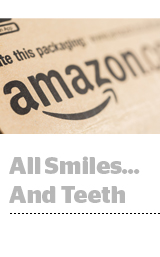 For those whose New Year’s wish was never to see the word “duopoly” again: Take cheer!
For those whose New Year’s wish was never to see the word “duopoly” again: Take cheer!
Soon we may start talking about the “triopoly” instead.
Amazon’s $1 billion to $2 billion per year in ad revenue in 2017, according to eMarketer estimates, may be a pittance to the tens of billions earned by Google or Facebook. But in the past year, the company has transitioned like a stalking predator from padded steps to a full-on assault of brand marketing dollars.
This year will see the opening of Amazon’s New York City office, housing 2,000 employees and serving as the headquarters of its advertising platforms business – not to mention the Whole Foods on the ground floor.
Here’s a look back at Amazon’s growth as a data-driven ad platform in 2017.
On Demand
Amazon Ad Platform (AAP) has surpassed Google’s DoubleClick Bid Manager as the most-used DSP for the first time, according to ad industry analytics firm Advertiser Perceptions’ annual industry report last year. “There’s a real trend where Amazon ad tech flies under the radar until it’s dominant,” said CSO Kevin Mannion.
Amazon’s adoption rate is high because any brand that sells on Amazon is going to have a seat for Amazon’s DSP (as must any such brand’s agency), said Emmy Spahr, programmatic director at the Publicis Groupe agency SapientRazorfish.
Amazon also worked with agencies to develop data and reporting features that differentiate its demand-side tech, said Rob Griffin, Havas Media’s EVP and global director of product development.
“To me, it feels like they’re going to the market and saying, ‘Let me see what else is out there,’” he said.
Amazon programmatic ecommerce ads have become a valuable tool for brands because they’re an effective way to return audiences to a “shopping mindset” when they put off a purchase, said Vik Kathuria, GroupM’s managing partner of corporate strategy and digital investments.
You Down With CPG?
Amazon has shaken brick-and-mortar retailers to their foundations, and marketing dollars are falling out of the cracks. [Primed comic]
Consumer product brands that form the backbone of grocery and convenience store sales are overhauling their marketing, often with deep cuts to digital advertising and in-store trade marketing budgets.
Amazon has benefitted from CPGs throttling media spend by soaking up investments that might otherwise go to programmatic exchanges or to in-store marketing.
Amazon’s $13.7 billion acquisition of Whole Foods and its private-label brands last summer hasn’t dampened the ecommerce leader’s scorching CPG growth.
In fact, Amazon has been pitching itself to CPG companies like Mondelez and General Mills as a cost-effective solution to retail expenses, Bloomberg reports. Product and package design or in-store displays, for instance, account for more overall CPG marketing dollars than programmatic.
Clorox now works with Amazon as a holistic tech and data partner, said one brand manager with the CPG giant. This partnership means ramping up the brand’s search and display advertising with AAP, but it also means Amazon targets opportunities to convert one-off sales into subscriptions, like when the ecommerce platform knows how long a user typically takes between re-purchasing cleaning supplies.
A paper towel brand also spiked its Amazon advertising and data services budgets in order to drive subscriptions. A brand manager for the company expects Amazon to use subscriptions as the metric for discoverability for voice search when Alexa-based voice shopping gains steam.
In Supply
Amazon’s splashiest moves in 2017 came in the retail and brand sector, but don’t sleep on its supply-side initiatives.
Amazon was one of the first companies to release a server-side header bidding solution, and has paced the market on header bidding SSP technology.
And Amazon’s investments in publisher ad-serving technology is scaling with the platform’s own media ambitions.
Amazon Prime had streaming rights to NFL games for the first time last year, and tested a product it’s developing for targeting and serving video ads to a live broadcast. That same technology is being put through its paces with linear TV advertising players like Simulmedia and Comcast’s FreeWheel.
Amazon’s video ad-serving product won’t compete with video players like JW Player or Brightcove, which connect advertisers with video inventory. It would be a metadata service operated by Amazon Web Services (AWS), Amazon’s cloud infrastructure business, to digest data on video viewership and enable personalization for streaming content, said Keith Wymbs, CMO of the Amazon video solutions business AWS Elemental.
This post was syndicated from Ad Exchanger.

More Stories
Dismantling Google Will Not Fix the Adtech Ecosystem
Meta’s Threads Begins Global Ad Rollout Within Its Feed
Adtech Firm Criteo Is Pitching Hundreds of Retailers on a New Video Ad